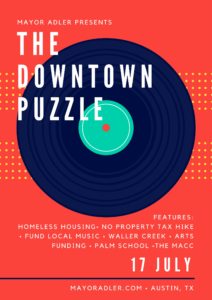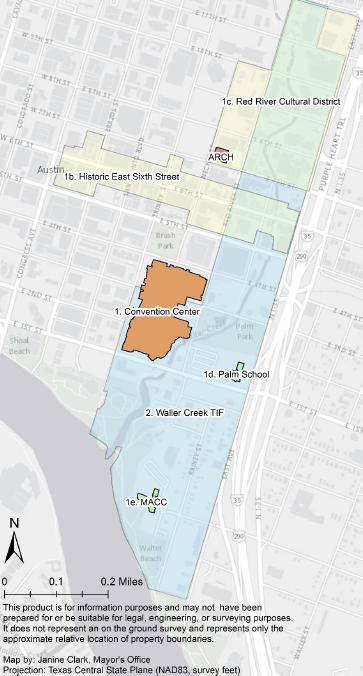 On Monday, Mayor Adler proposed a solution to the Downtown Puzzle, his name for the interconnected and geographically contiguous challenges in the eastern part of downtown Austin. After months of discussions with community groups represented at a City Hall press conference, the Mayor proposed harnessing downtown economic activity, including an expansion of the convention center, to raise $30 million for permanent supportive housing for the homeless and create an ongoing funding stream to address homelessness that starts at about $4 million a year until 2021 when it doubles. The Mayor’s proposal, which requires Council action, does not include any property tax increase.
On Monday, Mayor Adler proposed a solution to the Downtown Puzzle, his name for the interconnected and geographically contiguous challenges in the eastern part of downtown Austin. After months of discussions with community groups represented at a City Hall press conference, the Mayor proposed harnessing downtown economic activity, including an expansion of the convention center, to raise $30 million for permanent supportive housing for the homeless and create an ongoing funding stream to address homelessness that starts at about $4 million a year until 2021 when it doubles. The Mayor’s proposal, which requires Council action, does not include any property tax increase.
“We have figured out how to put the Downtown Puzzle together by making tourists pay to house the homeless and by harnessing the power of Austin to benefit all Austinites. This plan won’t raise your property taxes, will expand our tax base, and makes a big down payment on the moral imperative to house the homeless,” said Mayor Adler.
The elements of the plan begin with establishing a Tourism Public Improvement District (in which hotels tax themselves voluntarily) to create a revenue stream for homelessness. At first, this will yield about $4 million a year for homelessness, rising to approximately $8 million beginning in 2021.
Local hoteliers would only voluntarily do this if the City expanded the convention center. Doing this requires increasing the local hotel occupancy tax, or bed tax, to 17%, the maximum allowed under state law. Expanding the convention center is required by state law to increase the local bed tax. Doing so makes the following possible:
- 15% of the local portion of the bed tax is dedicated to the arts, which means an increase in bed tax revenues caused by the convention center expansion will accordingly increase funding for the local arts community.
- The local bed tax revenues will provide funding for preservation for the entertainment districts on East Sixth Street and Red River and funding for the local music industry.
- The bonding resulting from expanding the convention center will pay off the debt from the existing convention center ahead of schedule, freeing up 2 cents under the cap in 2021, and create capital funding to preserve the Palm School and to complete the Mexican-American Cultural Center.
The Mayor highlighted differences in the current convention center and the proposed expansion that will result in expanding the property tax base. The first and second floors of the expansion could be reserved for retail and restaurants, opening up a part of downtown to the public. Additionally, it’s envisioned that two towers will be built on top of the expansion, one for office use and one for affordable housing at 30% MFI.
 “We are literally creating affordable housing out of thin air,” said the Mayor. “I want this housing to be affordable to the people who work in the bars and restaurants downtown so we can better serve those who serve us.”
“We are literally creating affordable housing out of thin air,” said the Mayor. “I want this housing to be affordable to the people who work in the bars and restaurants downtown so we can better serve those who serve us.”
Because expanding the convention center will increase economic activity, the Downtown Puzzle envisions using a tool called Tax Increment Financing to capture the taxes generated downtown to finance improvements that benefit downtown. This will yield $30 million to build permanent supportive housing for an estimated quarter of those experiencing homelessness downtown.
“The ARCH is an intake facility with no outflow. We need housing for the homeless, and tourists are paying for it,” said Mayor Adler.
Housing the downtown homeless will increase the viability to build the Waller Creek chain of parks. To realize the vision of creating a world-class public park system on par with Manhattan’s High Line or Houston’s Discovery Green, the City could extend the Waller Creek TIF, bringing in an estimated $100 million that philanthropists and private funding would match. Creating an additional assessment for Waller Creek would provide for ongoing park maintenance.
The Mayor recognized the contributions of those who helped solve the Downtown Puzzle, including Homeless service provider community (notably ECHO, Caritas, Salvation Army, Front Steps), the Greater Austin Restaurant Association, the Downtown Austin Alliance, the Waller Creek Conservancy, parks and trails advocates, Palm School advocates, historic preservation advocates, Mexican-American Cultural Center supporters and board members, the live music community, members of the Cultural Arts Commission, Music Commission, and Quality of Life commissions, the Pecan Street Association, the Red River Merchants Association, arts advocates, SXSW, workforce advocates, the Hotel and Lodging Association, Austin Travis County Integral Care, Austin Police Department, and EMS.
Mayor Adler introduced the concept of the Downtown Puzzle in a Dec. 22, 2016 post on the Austin City Council Message Board in which he outlined a “comprehensive, integrated vision of one possible way to approach the future of a part of the downtown core and how it might serve as a major engine for preservation and progress. We’ve been considering these various issues separately for some time, but like a puzzle, maybe the pieces make the most sense when you see how they all could fit together.”
In May, 2017, the citizen-led Visitor Impact Task Force culminated six months of deliberation and formally adopted a recommendation that the City Council finance the expansion of the task force by increasing the city hotel occupancy tax without any impact on Austin’s general fund.
-30-
